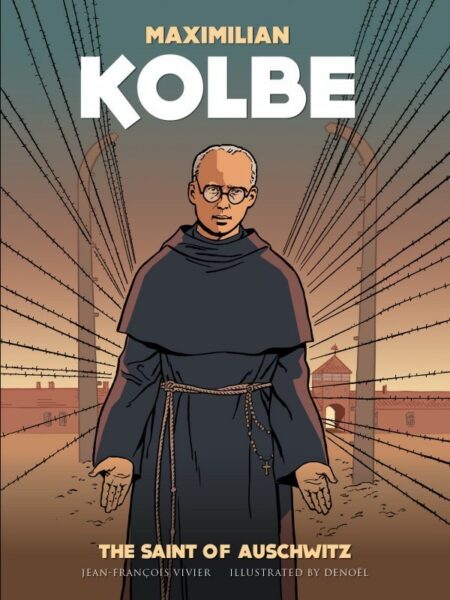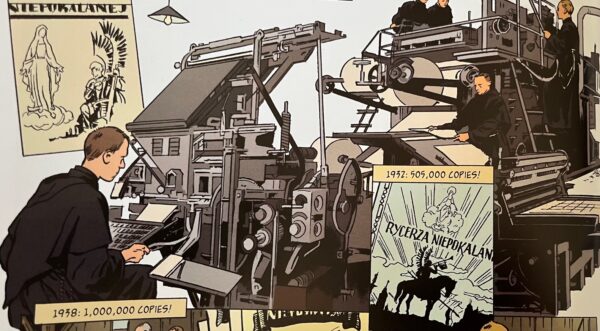Maximilian Kolbe: Graphic Novels for Catholics
 Continuing my series of reviews of graphic novels for Catholics, today I am going to share my thoughts on a beautifully illustrated work about one of the modern world’s most popular saints, the Polish Conventual Franciscan St. Maximilian Kolbe.
Continuing my series of reviews of graphic novels for Catholics, today I am going to share my thoughts on a beautifully illustrated work about one of the modern world’s most popular saints, the Polish Conventual Franciscan St. Maximilian Kolbe.
Maximilian Kolbe: The Saint of Auschwitz is an illustrated life of the great Polish martyr published by Sophia Institute Press. It was written by Jean-François Viver and illustrated by the Swiss artist Denoël. Originally published in France under the title Maximilien Kolbe, Un saint á Auschwitz by Artège in 2019, the Sophia edition is an English translation from the original French, translated by James Henri McMurtrie.
What I Loved About This Book
This book has a lot of strengths. It begins with Maximilian’s act of self-sacrifice in the starvation bunker at Auschwitz. Then, it tells his life story through flashbacks narrated through conversations with the inmates in the bunker. Narratively, I thought this was a very wise choice and is probably how I would have structured such a story as well. It allows interjections of questions from St. Maximilian’s cell mates that the book uses to guide the story and give it a solid narrative structure. It felt very cohesive, a “page-turner.”
The author also managed to weave in several ancillary stories as part of the main narrative. So, for example, we get the conversion story of Marie-Alphonse Ratisbonne, the story of St. Catherine Labouré and the miraculous medal, and the martyrdom of St. Paul Miki and companions, all fully illustrated. This was a very nice and unexpected addition.
I also liked that it was a comprehensive biography of St. Maximilian’s life. While Maximilian is famous for his self-sacrifice in Auschwitz, voluntarily taking the place of another prisoner who was condemned to death, the details of the rest of his life are not as well known. Thankfully, the book takes us through Maximilian’s entire life, devoting considerable attention to his impressive work as a publisher and a missionary in Japan. Even though I am familiar with St. Maximilian’s story, I still learned quite a bit!
Engaging Illustrations
The illustrations by Denoël are standard for contemporary graphic novels. I especially appreciated them for their historical detail. Since most of the book deals with St. Maximilian’s publishing endeavors with the Knights of the Immaculata magazine, there are many detailed drawings of historical printing presses. Drawing any piece of equipment accurately will always be challenging. I appreciate that Denoël went to the trouble to find pictures of printing presses from the 1920s and 30s as templates. He must have really enjoyed these images, as there are several throughout the book.
The pages have an almost steampunk feel. The same is true for the historical drawings of Maximilian’s monasteries in Poland and Japan. I really appreciated the architectural detail. I’m not sure if that would catch the attention of a twelve-year-old, but it sure caught my attention, so well done, Denoël.
Age Recommendation
Speaking of young kids, this book is not for the very young. Not because of the subject matter but because of the vocabulary and level of writing is geared. (I think the scenes in the concentration camp are handled with the right amount of decorum for readers of any age.) I think children under age ten would likely be unable to follow the text independently and would probably benefit from an adult reading it with them. I’d say the ideal audience is probably 12-14 year olds.
Finally, I loved that a few pages of photographs at the end of the book showed the historical images on which the illustrations were based. This was very cool.

An example of one of the “steam-punk” illustrations of the historical printing press
Left Wanting More
I enjoyed this book so much that I wish it were longer. The text is just 48 pages—and a 48-page picture book goes fast. This would be good for a young child (but as I said previously, this novel is best read aloud for younger children). For 12- to 15-year-olds, they could read through this book in a half-hour. I think one reason kids love graphic novels is the ability to just sink down into a chair and read one (or a series) over several sessions.
What is here is fabulous, so I’m hoping for more in the series. For example, during St. Maximilian’s stay in Japan, this graphic novel says that some of his brothers had to return to Poland because they were not acclimating well to the culture. A companion graphic novel could explore the concrete difficulties—maybe examples of brothers struggling to communicate with locals, or difficulty with climate, or some kind of tangible struggle that we can see unfolding on the page.
Another graphic novel could more deeply explore Maximilian’s time in the starvation bunker. The book uses this time as a kind of chronological anchor point from which Maximilian tells his life story, which is helpful. However, it does not deal with the actual struggle unfolding in the bunker. How does Maximilian internally process his suffering at the end of his life? What kind of conversations do he and the other prisoners have about God? How does his example affect them? I would love that book!
Historical Fiction
My one critique is that the book doesn’t appear to be comfortable with historical fiction. Much of the book’s narrative is matter-of-fact: “In 1933 Maximilian went here and did this, then in 1934 he went there and did this.” In my opinion, it would have greatly benefitted from showing more dramatized fictional situations of Maximilian working through this or that. By omitting this, the book becomes more of an illustrated biography about St. Maximilian than a graphic novel. If that is the goal, then it is accomplished quite admirably.
Conclusion
In conclusion, Maximilian Kolbe: A Saint of Auschwitz is a wonderful introduction to the life and mission of the great martyr of Auschwitz. The details of his life are covered comprehensively, and the illustrations are beautiful and full of historical detail. Also admirable is the emphasis on St. Maximilian’s Marian spirituality. It would make an edifying addition to your home library’s collection of saint books. You can purchase it here from Sophia Institute Press.
We’ll have more about homeschooling and Catholic graphic novels in future installments. But what about you? Have you added graphic novels to your homeschool library? Join me and other homeschooling parents at our Homeschool Connections Community or our Facebook group to continue the discussion!
NOTE: This article contains affiliate links.






